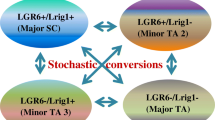Summary
The clustering of3HTdR labelled cells in the epidermal basal layer and their changes with time have been modelled mathematically and cannot be adequately fitted by an earlier model of the cell kinetic organisation of the skin. A more refined model analysis was performed based on Monte Carlo computer simulations of cell layers which take cell division, cell aging and lateral as well as vertical cell migration into account. A large variety of hypothetical scenarios was tested to see if each could provide a fit to the clustering data. The analysis provides further support for the concept of a cell kinetic heterogeneity with a stemtransit-postmitotic differentiation scheme. In the best overall model scheme three transit divisions are predicted but unlike in the earlier model it is now postulated that postmitotic cells can be produced at all stages in the lineage rather than only at the end of the amplification scheme. Most important, the model predicts that stem cells and most of the transit cells differ in the way they process3HTdR label. Grain dilution is an important mechanism to explain the fate of some labelled cells in the tissue, but on its own it can only consistently explain the data if the stem cells have a very low labelling index (LI ≤ 1 %) which implies a very short biologically unreasonable S-phase. If a higher LI (longer S-phase) is assumed for the stem-cells other mechanisms must be predicted to explain the lack of large clusters and the increase in time of the singles. The selective segregation of chromosomes at mitosis is one such mechanism. However, on its own a large number of cells would have to behave in this way (i.e. both stem and T1 cells). If combined with other assumptions such as some grain dilution this selective segregation may be restricted only to stem cells. In addition the model allows cell production and migration rates to be estimated and the analysis can be related to the EPU-concept. Indeed the model itself would tend to automatically generate an EPU like structure. The model quantitatively reproduces LI, PLM, CL and clustering data.
Similar content being viewed by others
References
Aarnaes E, Thorud E, Clausen OP (1981) Model analysis of circadian rhythms in mouse epidermal basal cell proliferation. J Theor Biol 88:355–370
Allen TD, Potten CS (1974) Fine structural identification and organisation of the epidermal proliferation unit. J Cell Sci 15:291–319
Burns FJ, Tannock IF (1970) On the existence of a Go-phase in the cell cycle. Cell Tissue Kinet 3:321–334
Cairns J (1975) Mutation selection and the natural history of cancer. Nature 225:197–200
Chwalinski S, Potten CS (1986) Cell position dependence of labelling of thymidine nucleotides using the de novo and salvage pathways in the crypt of small intestine. Cell Tissue Kinet 19:647–659
Hume WJ, Potten CS (1982) A long lined thymidine pool in epithelial stem cells. Cell Tissue Kinet 15:49–58
Iversen OH, Bjerknes R, Devik F (1968) Kinetics of cell renewal, cell migration and cell loss in the hairless mouse dorsal epidermis. Cell Tissue Kinet 1:351–367
Loeffler M, Potten CS, Ditchfield A, Wichmann HE (1986a) Analysis of the changes in the proportions of clustered labelled cells in epidermis. Cell Tissue Kinet 19:377–389
Loeffler M, Stein R, Wichmann HE, Potten CS, Kaur P, Chwalinski S (1986b) Intestinal cell proliferation-I. A comprehensive model of steady state proliferation in the crypt. Cell Tissue Kinet 19:627–645
Potten CS (1974) The epidermal proliferative unit: The possible roll of the central basal cell. Cell Tissue Kinet 7:77–88
Potten CS (1975) Epidermal cell production rates. J Inv Dermatol 65:488–500
Potten CS (1976) Identification of clonogenic cells in the epidermis and the structural arrangement of the epidermal proliferative unit. In: Cairnie AB, Lada PK (eds) Stem cells of renewing cell propulations. Academic Press, New York, 91–102
Potten CS (1977) Extreme sensitivity of some intestinal crypt cells to X and gamma-irradiation. Nature 269:518–521
Potten CS, Loeffler M (1987) Epidermal cell proliferation: I. Changes with time in the proportions of isolated, paired and clustered labelled cells in sheets of murine epidermis. Virchow’s Archiv (Cell Pathol) 53:279–285
Potten CS, Hendry JH (1973) Clonogenic cells and stem cells in epidermis. Int J Radiat Biol 24:537–540
Potten CS, Hendry JH, Al-Barwari SE (1983) A cellular analysis of radiation injury in epidermis. In: Potten CS, Hendry JH (eds) Cytotoxic insults to tissue. Churchill Livingstone, Edinburgh, pp 153–185
Potten CS, Hume WJ, Parkinson EK (1984) Migration and mitosis in the epidermis. Br J Dermatol 111: 695–699
Potten CS, Hume WJ, Reid P, Cairns J (1978) The segregation of DNA in epithelial stem cells. Cell 15:899–906
Potten CS, Wichmann HE, Dobek K, Birch J, Codd TM, Horrocks L, Pedrick M, Tickle SP (1985) Cell kinetic studies in the epidermis of mouse-III. The percent labelled mitosis technique (plm). Cell Tissue Kinet 18:59–70
Potten CS, Wichmann HE, Loeffler M, Dobek K, Major D (1982) Evidence for discrete cell kinetic subpopulations in mouse epidermis based on mathematical analysis. Cell Tissue Kinet 15:305–329
Smart IHM (1970) Variation in the plane of cell cleavage during the process of stratification in the mouse epidermis. Br J Dermatol 82:276–282
Thorud E, Clausen OP, Aarnaes E, Bjerknes R (1979a) Circadian changes in cell cycle phase durations in murine epidermal basal cells. Chronobiol 6:163
Thorud E, Clausen OP, Aarnaes E, Bjerknes R, Elgjo K (1979 b) Circadian rhythms in epidermal basal cell proliferation. Cell Tissue Kinet 12:685–686
Wichmann HE, Fesser K (1982) Influence of 3HTdR on the circadian rhythm — A model analysis for mouse epidermis. J Theor Biol 97:371–391
Wichmann HE, Franke H, Potten CS, Todd L (1987) Modelling of the influence of 3HTD on cell kinetics in mouse epidermis. Adv Math Comput Sci Med (in press)
Wright N, Alison M (1984) The biology of epithelial cell populations, vol 1, 2. Clarendon Press, Oxford, 1247 pp
Author information
Authors and Affiliations
Rights and permissions
About this article
Cite this article
Loeffler, M., Potten, C.S. & Wichmann, H.E. Epidermal cell proliferation. Virchows Archiv B Cell Pathol 53, 286–300 (1987). https://doi.org/10.1007/BF02890255
Received:
Accepted:
Issue Date:
DOI: https://doi.org/10.1007/BF02890255




